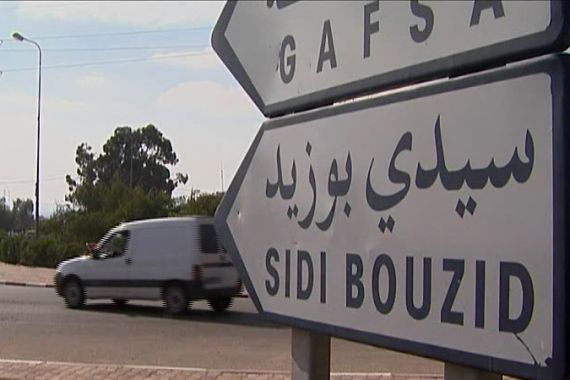Tunisia: The uprising that started it all
Tunisians overthrew government, inspired uprisings across the region and launched their country on track to democracy.

 |
| The protests began amidst rising anger over unemployment and poor living conditions in Tunisia [AFP] |
In 2011, Tunisians managed to overthrow the ruling government, inspire uprisings across the region and launch their country on the fast track to democracy.
The small north African nation set an astounding tempo for 2011, bringing revolutionary fervour back to the Arab world with a gusto that had been largely absent from the region since the anti-colonial revolts of the 1950s and ’60s.
Zine El Abidine Ben Ali’s repressive government may have been in power for three long decades, but the country was better known as a favoured destination for bargain-hungry European tourists than for the human rights abuses committed by the ruling elite.
In a few short weeks, Tunisians shattered all the clichés.
The Tunisian uprising was triggered when a young fruit vendor, Mohamed Bouazizi, set himself alight in the marginalised town of Sidi Bouzid on December 17. In January, it snowballed from a local rebellion into a nationwide movement.
In the New Year, the uprising caught the attention of the international cyberactivist collective Anonymous, which launched ‘Operation Tunisia’ on January 2 in a bid to capture the world media’s attention.
Bouazizi’s death from his burns on January 4 struck a further blow to Ben Ali’s efforts to cling to power.
Likewise, the national lawyers’ union was a driving force in the uprising, with its members standing side-by-side, the country’s youth began to demand social justice and political freedom. The overwhelming majority of Tunisia’s lawyers joined a nationwide strike on January 6, denouncing the security forces’ violent repression of the protests.
The worst atrocities of the uprising happened in the central towns of Kasserine and Thala, when security forces slew dozens of protesters in the streets.
Images of the dead – shared on Facebook, Twitter and aired on satellite television channels including, Al Jazeera – shocked Tunisians who had until then kept their dissent to themselves. Thousands joined a historic march in the capital on January 13, on Avenue Habib Bourguiba.
In response to the protests, Ben Ali spoke on national television that night. “Enough firing of real bullets. I refuse to see new victims fall,” he said. Minutes after his speech, more protesters were shot.
By January 14, as crucial members of his own security personnel turned against him, accompanied by his much-despised wife, Leila Traboulsi, Ben Ali tried to escape to Paris, but found his former allies in Paris refusing to welcome him. Instead, he sought refuge in Saudi Arabia.
Although Tunisian protesters ousted their leader with far greater ease than would be the case elsewhere in the region, the uprising was hardly bloodless.
At least 219 people were killed and hundreds more injured at the hands of the security forces, according to a UN investigative panel.
Politically, much has changed. By October, the country went to polls for what was widely hailed as the country’s first genuinely democratic election, with Ennahdha, the moderate Islamist party, emerging as the winner.
Moncef Marzouki, a longtime rights activist and outspoken critic of the former president, is now the president of Tunisia.
But as the year draws to a close, many Tunisians say they will only judge the uprising as a success when they achieve the economic and social changes for which they took to the streets.